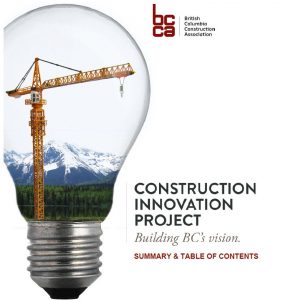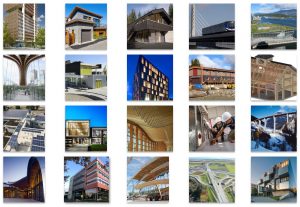A blueprint for the construction industry from Canada's West Coast
Contents |
[edit] Introduction
In a world powered by innovation, action is needed to ensure that British Columbia’s construction companies are ready to meet the challenges ahead.
It’s hard to overstate the importance of construction to BC’s economy. As a $16.5 billion dollar industry it provides 8% of the province’s GDP and employs more than 200,000 workers, making construction one of BC’s largest employers. This means innovation is vital for the continued prosperity of Canada’s most western province.
The industry’s future includes profound regulatory, technical, demographic, macro-economic and consumer changes that will impact every aspect of construction. National and international factors such as an aging population, climate change and the digital design revolution are changing the needs and expectations of regulators, clients and end-users and also putting pressure on the industry to integrate new ideas, technologies and specifications into their projects.
BC construction firms will have to adapt and innovate or risk being left behind. Although BC is strong in green building and wood technologies, we have catching up to do in other areas. Public and corporate investment in innovation in BC lags behind other highly developed countries.
The mechanisms for knowledge sharing and collaboration outside of projects do not exist. Fundamentally, the industry has not fostered a culture of innovation that transcends day-to-day problem solving on a construction site.
These gaps are concerning because innovation is the ultimate source of long-term economic growth and competitiveness. The ability to create new products, techniques and services, to find novel uses for existing products and to develop new markets provides will ensure success in the twenty-first century.
This 'call to action' is meant for general contracting and trade companies and the many stakeholders that are involved with construction in BC. Our report makes the case that engaging pro-actively with innovation can have a positive impact on business and the ability of businesses of all sizes to succeed. It outlines the key challenges that have to be overcome and highlights the need for a 'made-in-BC' construction innovation action plan that can serve as a model for the rest of the country.
[edit] The state of innovation in BC’s construction industry
Innovation can be defined as the successful introduction of new technologies or procedures into industry. The scope of innovation in the construction industry is broad and applies to everything from building products, materials and systems to construction techniques, equipment and business operations.
The need for more innovation and better innovation deployment systems in the construction sector is well recognised. Compared to other industries, construction in most regions (including BC) remains largely locally-focused, undiversified and with relatively small export markets. Despite the fact that it is a major market for the tech sector, there is no construction-specific innovation platform on which to engage with the R&D and start-up community.
External forces such as changing societal demands and expectations, the increasingly globalised market and business climate, labour market challenges and advances in knowledge and technology are creating new pressures for construction companies to innovate.
Although it may affect individual businesses very differently, there is general agreement that the way construction gets done ten years from now will be very different from today. Innovation will be essential to the industry as a whole to reduce capital construction costs, improve productivity, increase the number of projects completed on time and within budget, and reduce the number of defects and accidents. Investment in innovation can also help companies to differentiate, improve their reputation and compete for the next generation of talent in a tight labour market.
It is imperative for the industry to continue to innovate in response to these drivers or risk being left behind. Construction industry members say that cost of materials and energy, an aging workforce, the need for workers with higher qualifications and sustainability are the four most important drivers of innovation in BC. They are manifesting themselves in trends such as low carbon design, the digital revolution and the influx of cheap products (and labour) from overseas.
There are several areas of strength that the construction industry can leverage as a starting point to build a culture of innovation. BC’s economy has strong prospects for growth with low interest rates and an attractive corporate tax regime. The industry has expertise in wood design, construction and the infrastructure that supports the development of innovative wood products, capabilities in digital technologies and building envelope design, testing and assembly. BC builders can also put up a concrete high rise building faster than most.
The next generation of talent is putting a fresh face to the industry and a new federal government brings concrete commitments to investing in Canada. The BC construction industry’s leadership in green building and in all sorts of innovative applications of wood technologies is coming to the fore just at the moment when the world is looking to the built environment to mitigate environmental and social challenges.
However, the industry also faces challenges — such as the number of stakeholders, risk aversion, the lack of a culture of learning and short term thinking — that are deeply rooted and will be very difficult to dislodge. The threats of continued low productivity, lack of attractiveness as a career path to new workers, and an unsatisfactory reputation (whether justified or not) will only become greater as the regulatory framework continues to become more challenging, materials costs go up and the labour shortage becomes increasingly acute.
BC is well positioned to tackle the challenges that lie ahead, but it will take a concerted effort. Creating a culture of innovation will not just happen by itself – it requires the commitment, investment and determination of the industry as a whole.
[edit] A vision for BC’s construction industry
Our latest report shows that embracing innovation will improve project and business performance and position BC construction companies for success. However, a comprehensive industrial action plan is needed to coordinate efforts and catalyze and capture industry innovation.
We present the case for such a plan and offer five foundational pillars to serve as a guiding framework:
- Leadership – A cohesive industry that embraces and celebrates innovation
- Performance — A responsible industry that continually improves projects’ economic, environmental and social performance
- People – A talented industry that attracts a skilled, technologically-savvy workforce
- Growth and Resilience – An efficient, competitive and profitable industry that drives economic growth
- R&D – An advanced industry that develops and implements innovative new products, processes and business strategies.
These five pillars lay out an aspirational innovation program of ambitions and recommended activities for the province that reflect best practices and the strengths and weaknesses of the BC construction industry. Their successful implementation will require broad support from government, research organisations and the construction industry as a whole.
Please read the full report here, available on the British Columbia Construction Association (BCCA) website.
Please read a Summary of the BCCA Construction Innovation Project 2016 here.
Written by:
- Helen Goodland, Principal, Brantwood Consulting Partnership.
- Chris Lindberg.
- Paul Shorthouse.
This article was originally published on the Future of Construction Knowledge Sharing Platform and the WEF Agenda Blog
--Future of Construction 15:14, 20 Jun 2017 (BST)
[edit] Related articles on Designing Buildings Wiki
- 10 construction industry trends to watch in 2017.
- Blockchain could transform the construction industry.
- Construction innovation.
- Future of seaside towns.
- Innovation in construction projects.
- Shaping the Future of Construction: Inspiring innovators redefine the industry.
- The future of construction - BIM.
- Unprecedented Innovation and New Technologies on the Horizon.
Featured articles and news
Infrastructure that connect the physical and digital domains.
Harnessing robotics and AI in challenging environments
The key to nuclear decommissioning and fusion engineering.
BSRIA announces Lisa Ashworth as new CEO
Tasked with furthering BSRIA’s impressive growth ambitions.
Public buildings get half a million energy efficiency boost
£557 million to switch to cleaner heating and save on energy.
CIOB launches pre-election manifesto
Outlining potential future policies for the next government.
Grenfell Tower Inquiry announcement
Phase 2 hearings come to a close and the final report due in September.
Progress from Parts L, F and O: A whitepaper, one year on.
A replicated study to understand the opinion of practitioners.
ECA announces new president 2024
Electrical engineer and business leader Stuart Smith.
A distinct type of countryside that should be celebrated.
Should Part O be extended to existing buildings?
EAC brands heatwave adaptation a missed opportunity.
Definition of Statutory in workplace and facilities management
Established by IWFM, BESA, CIBSE and BSRIA.
Tackling the transition from traditional heating systems
59% lack the necessary information and confidence to switch.
The general election and the construction industry
As PM, Rishi Sunak announces July 4 date for an election.
Eco apprenticeships continue help grow green workforce
A year after being recognised at the King's coronation.
Permitted development rights for agricultural buildings
The changes coming into effect as of May 21, 2024.

























